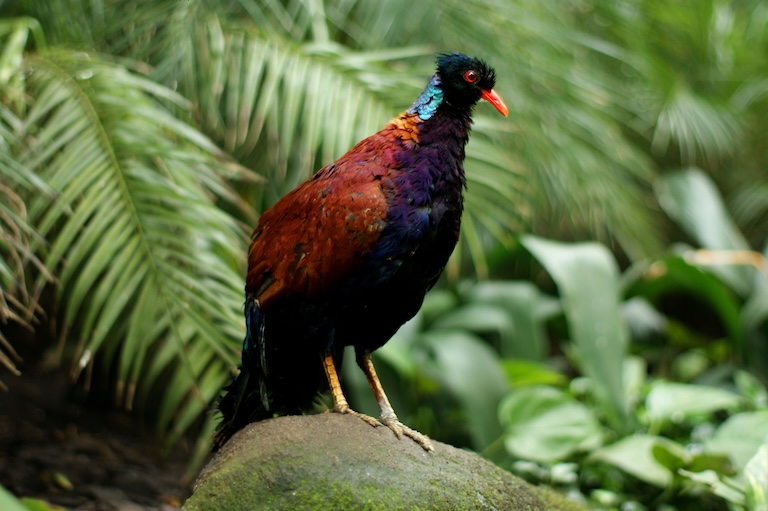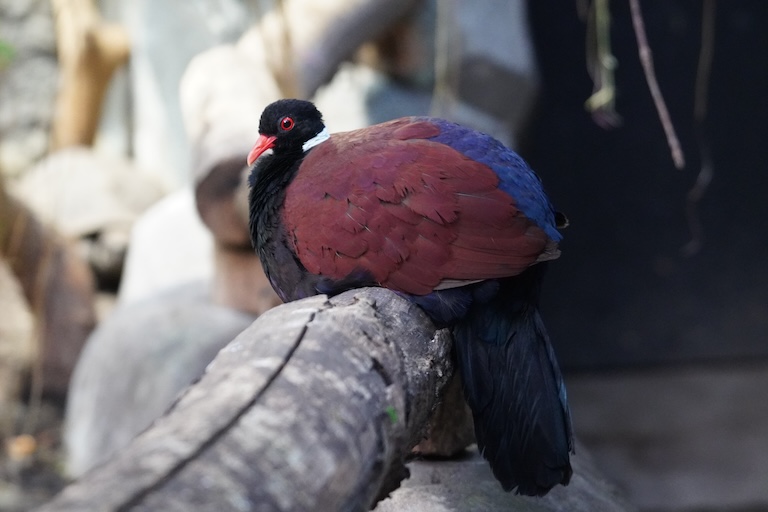Pheasant Pigeon Profile
It’s difficult to comprehend the sheer size and age of the forests in Southeast Asia. Some of the rainforests are thought to be 140,000,000 years old, which means they came about not long after the Jurassic period ended, and Papua New Guinea is the second-largest island in the world.
So, it’s no wonder that a lot of the wildlife in it is totally unknown, and a lot of what is known is incredibly hard to study. It also makes the rampant deforestation in the country all that more tragic.
But despite the destruction, there’s still a huge amount of forest left, more than enough to have hidden one of the subspecies of pheasant pigeon from scientists for about 140 years: an animal only rediscovered in 2022.

Pheasant Pigeon Facts Overview
| Habitat: | Hilly, montane rainforests |
| Location: | Aru Islands, Indonesia; New Guinea |
| Lifespan: | Unknown |
| Size: | Around 45cm (18 in) long |
| Weight: | Around 500 g |
| Colour: | Mostly black with brown wings, and a white, green, grey, or black nape |
| Diet: | Fruits and seeds |
| Predators: | Unknown |
| Top Speed: | Unknown |
| No. of Species: | 1 |
| Conservation Status: | Least Concern |
The pheasant pigeon was once thought to be a species group made up of what are now considered four subspecies of large, heavy, terrestrial pigeons from New Guinea and Indonesia.
One in particular was recorded in the late 1800s from a single specimen and then never heard from again. Until that is, it showed up on the trail cam of some researchers just a couple of years ago.
These pigeons are incredibly elusive, so not a lot is written about them yet, but they seem to be doing well enough to be of least concern to conservationists, despite their slow reduction in number and their habitats shrinking terrifyingly fast.
Interesting Pheasant Pigeon Facts
1. They’re lonely
This large, terrestrial pigeon is still not very well known, and considering how elusive it’s been to researchers, this might change in the near future, but for now, it’s the only known species in its genus, Otidiphaps, which is a reference to another heavy waddler, the Bustard.
The pheasant pigeon isn’t a bustard, though, and it’s not a pheasant, either. It’s a regular old pigeon, albeit not a very regular one, in many ways. It’s endemic to New Guinea, where it was once thought to be four species of similar bird, but has since been collapsed into four subspecies of the same one.
This change in its taxonomy hasn’t been accepted by all institutions yet, and may never be, but for now, we will consider it one lonely species.
Of course, this is a taxonomic loneliness, and the bird itself is probably quite content with its community of four subspecies. 1

2. They’re heavy
This comparison with the bustard reflects how bulky the pheasant pigeon is. It has strong helgs and a dense body, suited to its forest floor existence.
It has relatively short and small wings which are compressed and rounded in a strange way, though it is capable of flight. From the literature, it’s said to make a lot of noise as it does though, clattering through the forest when disturbed.
And this ability to evade human detection is what keeps them from being understood in a zoological context.
These pigeons stay well away from human settlement, too, which makes local knowledge of them limited, and they’re so good at hiding that it wasn’t until recently that we even knew they still existed. 2
3. They were thought to have gone extinct
There are some people lucky enough to get paid for roughing it around ancient rainforests, setting up camera traps and collecting photos of secretive animals.
It’s not as romantic as it might seem, of course, with all the malaria and yellow fever and so on, but it’s certainly a more rewarding role than most, especially when you hit the jackpot.
And in 2022, a small team did just that, when their camera trap picked up a pheasant pigeon, a month into their mountainous journey, and just hours before they were about to head home.
This event was described as the most surreal moment of the researcher’s life, and that’s not just because it was a rare bird, but because it was so rare, that people thought it no longer existed.
The bird they found was the black-naped pheasant pigeon, the last sighting of which before 2022 was in 1882, 140 years prior, and that was a dead one. 3 4
4. They’re in decline
While this is excellent news, the future is still uncertain for the bird.
The very land the recent discovery was made on had already been sold off to a logging company, and should campaigners be unable to protect it, this will be another bunch of unique forest habitats destroyed.
It’s inferred that the species as a whole is facing similar problems across its range and will likely be in decline. This is a species that relies on primary, old-growth forests, so once that’s gone, no amount of tree planting will be enough to save it. 5
5. But they’re not necessarily threatened yet
The land in those parts is truly vast, and there is still hope to rescue it from total destruction.
BirdLife International treats the Black-naped Pheasant Pigeon as a full species and classifies it as Critically Endangered.
But other world bird taxonomies still recognise a single species, and of the four subspecies, only the white-naped pheasant pigeon is Vulnerable, while the others are of least concern.
Going by the single-species taxonomy, the pheasant pigeon isn’t thought to be threatened yet – and there are many more pressing ones to consider in New Guinea – so its wide range may be enough to keep it protected for now.

Pheasant Pigeon Fact-File Summary
Scientific Classification
| Kingdom: | Animalia |
| Phylum: | Chordata |
| Class: | Aves |
| Order: | Columbiformes |
| Family: | Columbidae |
| Genus: | Otidiphaps |
| Species: | nobilis |
Fact Sources & References
- Guy M. Kirwan (2023), “Remarks on the types of the New Guinea endemic Otidiphaps Gould”, BioOne Digital Library.
- Glenny, F. H (2014), “Remarks on the Pigeon, Otidiphaps nobilis Gould”, Sci Hub.
- Andy McGlashen (2022), “‘Like Finding a Unicorn’: Researchers Rediscover the Black-Naped Pheasant-Pigeon, a Bird Lost to Science for 140 Yearse”, Audubon.
- Zoe Sottile (2022), “This bird hadn’t been documented by scientists since 1882. Then they captured video of it in Papua New Guinea”, CNN World.
- Pat Leonard (Year), “‘Lost’ pigeon found after more than a centurye”, Cornell Chronicle.
